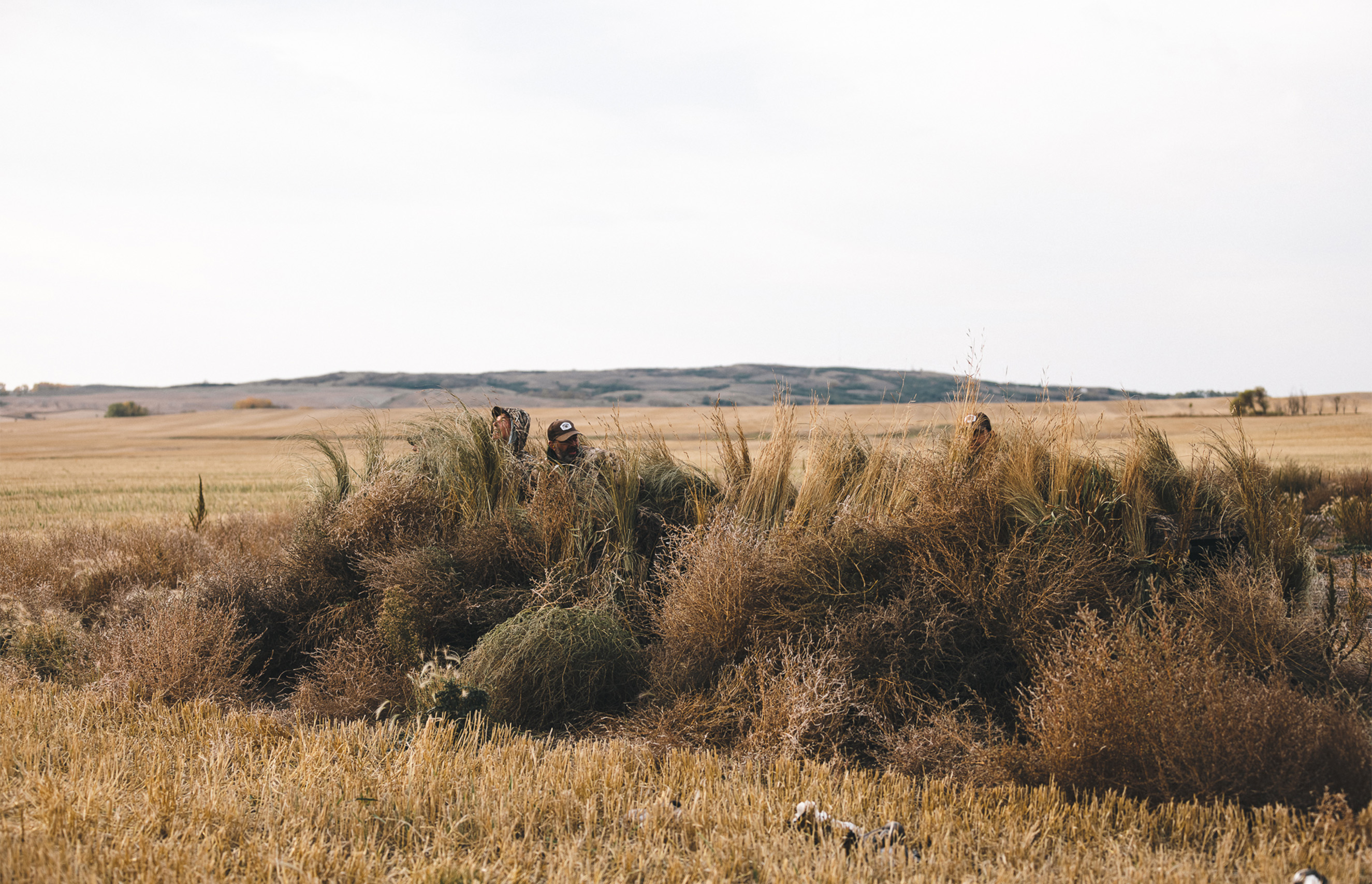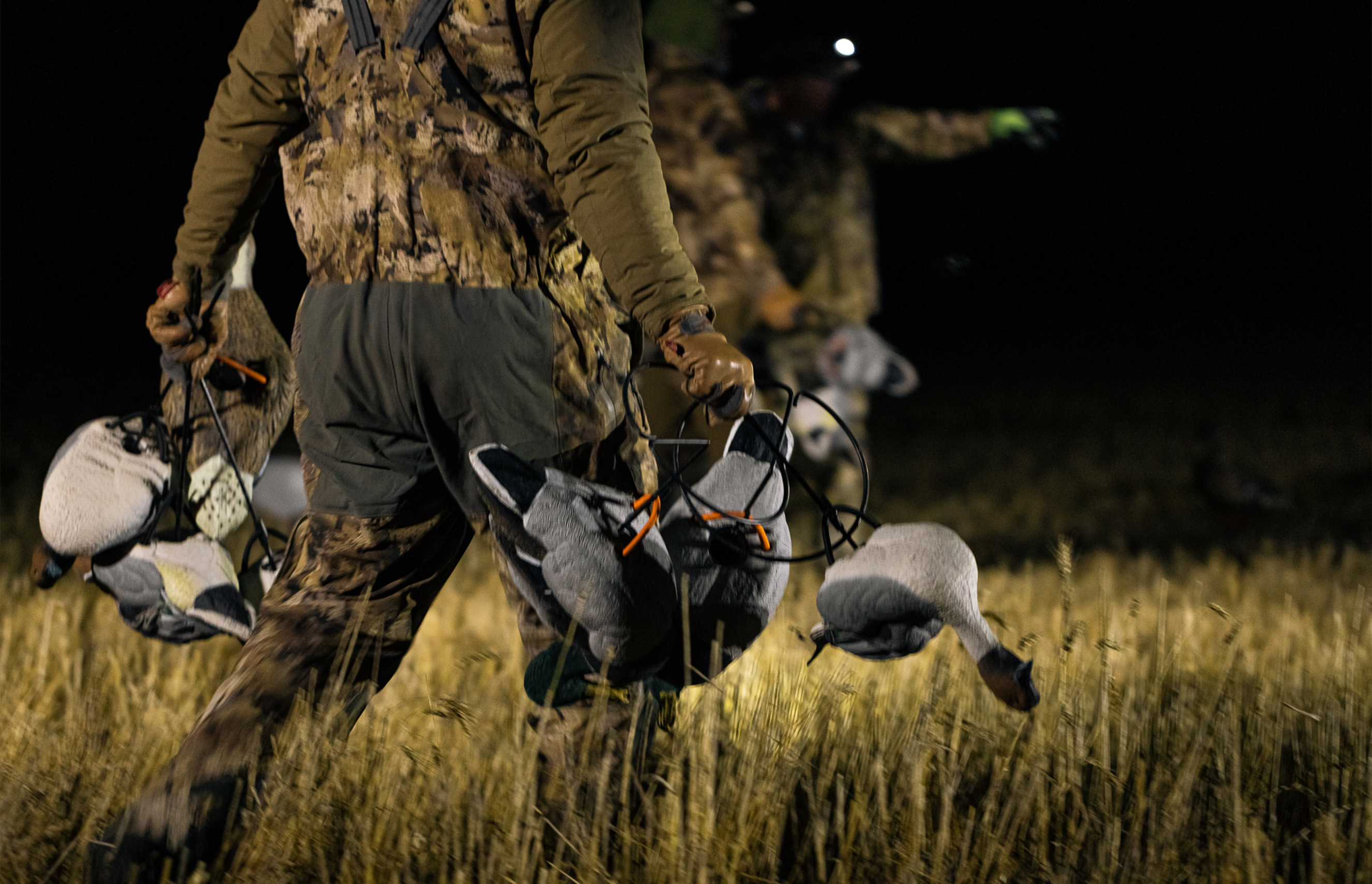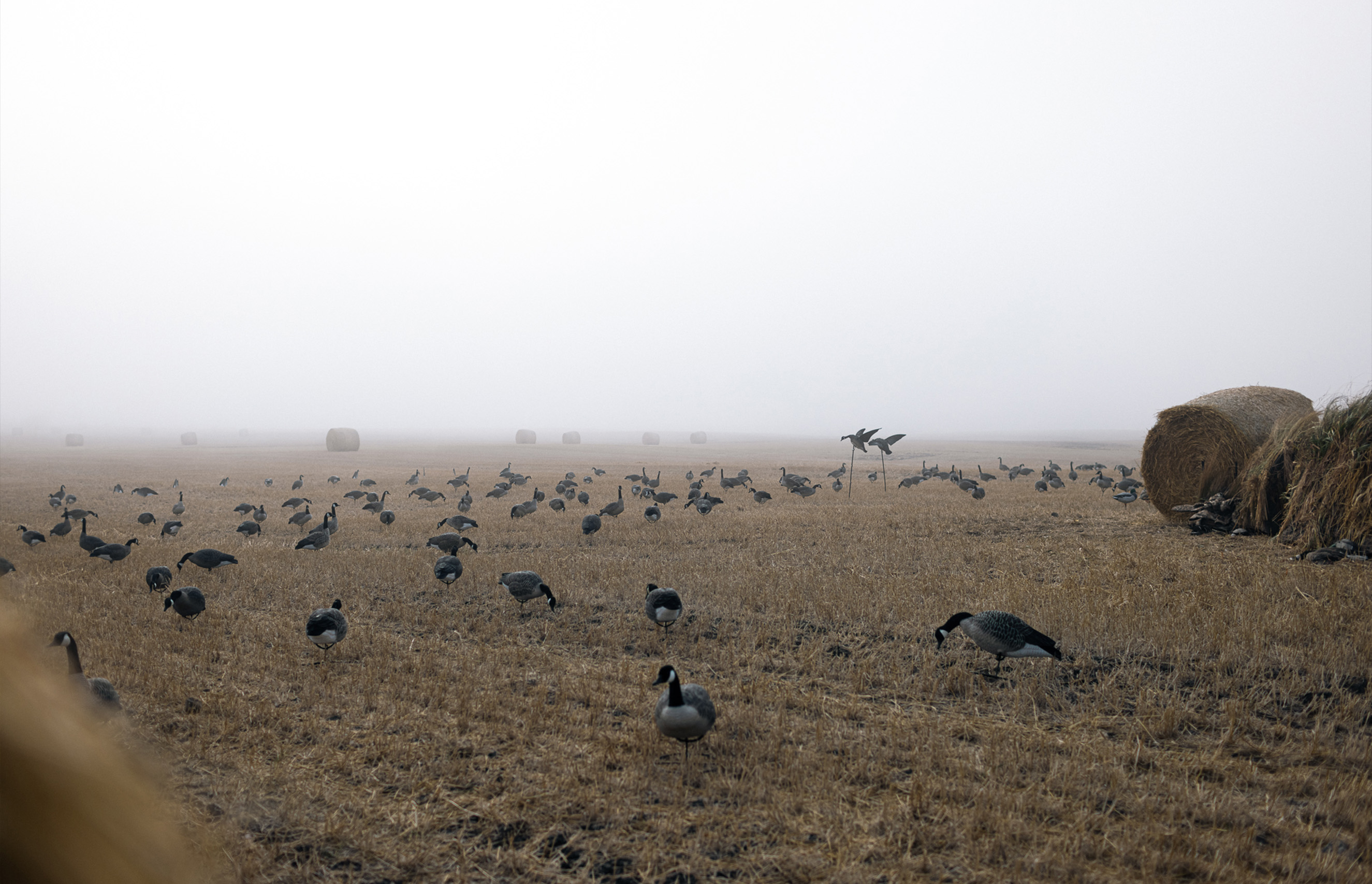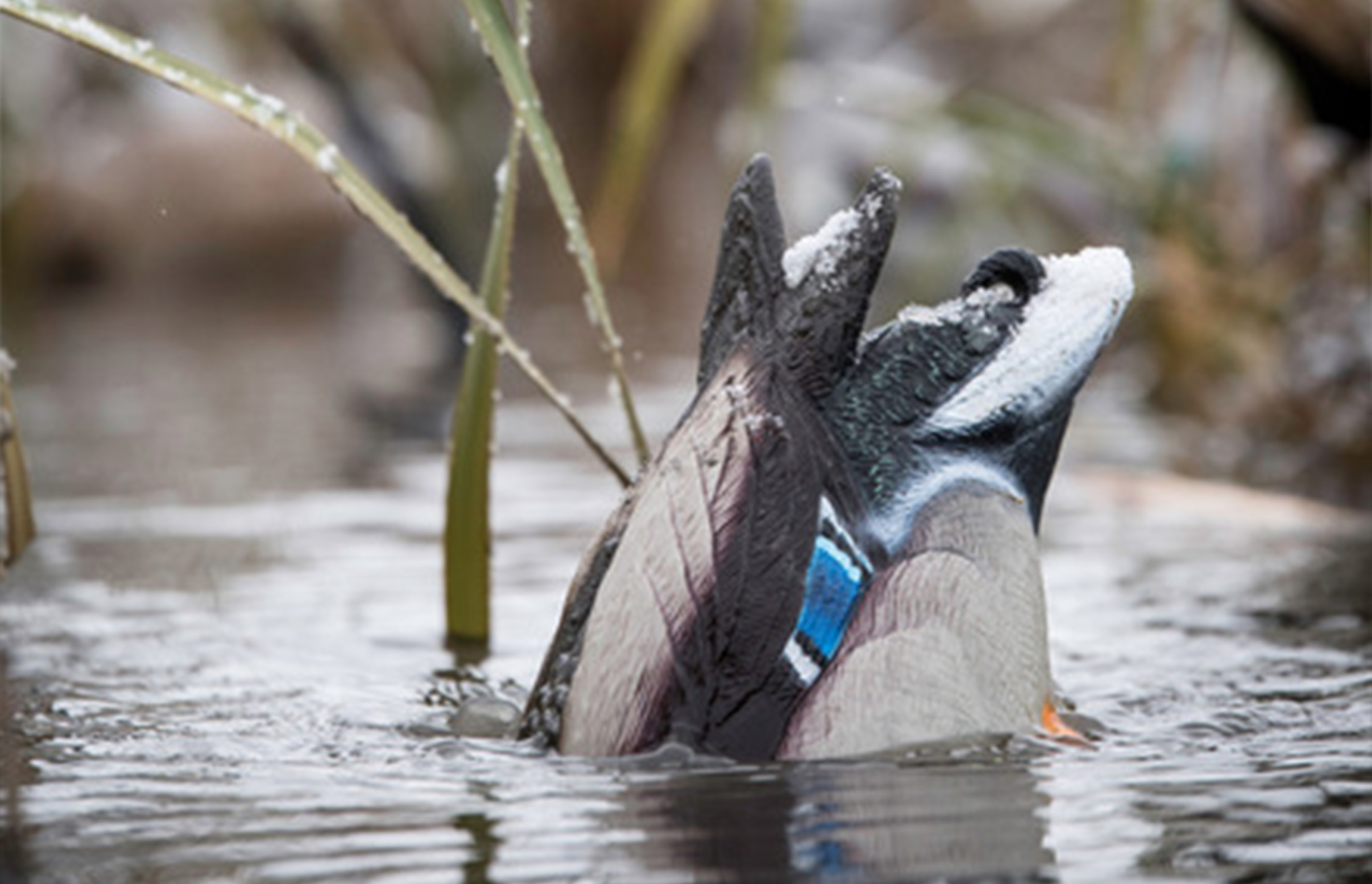How to Place Your Decoys for Effective Slot Patterns
Posted by Lucky Duck Team on Sep 25th 2024

Understanding the Slot Pattern Decoy Spread
The slot pattern decoy spread is a strategic setup that creates an inviting landing zone for ducks while guiding them into the optimal shooting area. The core idea behind the slot pattern is to divide your decoy spread into distinct groups, leaving a clear gap—or "slot"—between them. The decoys block some areas and keep the ducks from landing there while the gap in between groups encourages ducks to land exactly where you want them, typically right in front of your blind or shooting position.
In a typical slot pattern, you might divide your decoys into two or three groups, spaced out enough to leave a landing zone in the middle. This setup is particularly effective because it mimics natural duck behavior, where birds tend to land in open spaces within a flock. By strategically placing your decoys in a way that directs ducks toward this slot, you increase the likelihood of them committing to your spread and giving you a perfect shot opportunity.
Slot patterns are versatile and can be adjusted based on the number of decoys you have and the specific hunting conditions you face. Whether you're working with a small spread on a quiet pond or a larger setup on open water, understanding the basics of the slot pattern will help you create a more convincing and effective spread to decoy your birds in right where you want them.
Choosing the Right Location for Your Slot Pattern Setup

The effectiveness of a slot pattern decoy spread is significantly influenced by where you choose to set it up. Location is everything in waterfowl hunting, and even the best decoy arrangement will fall flat if it’s not in the right spot. When selecting a location for your slot pattern, consider a few key factors:
- Scouting: Before you even think about setting up your decoys, spend time scouting the area. Look for spots where ducks naturally congregate, such as feeding areas, resting spots, or flight paths. If you’re hunting on water, check for places where ducks are frequently landing or swimming. Don’t just see which bodies of water they gravitate to; try to learn where go like to go under certain conditions.
- Natural Cover: Your blind or shooting position should be well-concealed, ideally using natural cover like reeds, bushes, or trees. The slot pattern works best when ducks feel safe enough to land in the open area you've created, so your concealment is crucial.
- Water Depth and Conditions: If you’re setting up on water, make sure the area is shallow enough for your decoys to float naturally but deep enough that ducks are comfortable landing. Also, consider the water's clarity and any currents that might affect your decoys' positioning.
- Visibility: Ducks should be able to see your decoys from a distance to be drawn in. Choose a location with good visibility, where your decoys will stand out against the surroundings. Open water, fields with minimal obstructions, or clearings in flooded timber are all good options.
By carefully selecting your location, you can ensure that your slot pattern decoy spread is in a place where it’s most likely to attract ducks and lead to a successful hunt.
How Wind Direction Influences Slot Pattern Effectiveness
Wind direction is one of the most critical factors in the effectiveness of a slot pattern decoy spread, so be prepared to accommodate it. Ducks naturally prefer to land into the wind, using it to slow down and control their descent. By aligning your slot pattern with the wind direction, you can guide ducks to land exactly where you want them—ideally right in the middle of your spread.
Here’s how to make the wind work in your favor:
- Positioning the Slot: Set up your decoys so that the slot, or landing zone, is directly downwind from your shooting position. This way, ducks approaching the spread will be flying into the wind, slowing their approach and giving you a better shot opportunity as they attempt to land.
- Adjusting for Wind Speed: On windy days, ducks may land closer to the edge of the spread or even outside the slot if the wind is too strong. In these conditions, you might need to tighten up your decoy groups to narrow the slot or position your decoys slightly farther upwind to account for the stronger breeze.
- Handling Shifting Winds: If the wind changes direction during your hunt, be prepared to adjust your decoy spread. A shift in wind direction may turn your otherwise effective setup into a missed opportunity if ducks start landing outside your intended zone. Keep an eye on the weather and be ready to reposition your decoys as needed.
- Wind and Decoy Movement: Wind also affects the movement of your decoys and adds realism to your spread, though not as much as if you’re using motion decoys like the Super Swimmer HDI. Properly placed motion decoys can add realism by creating natural-looking ripples and movement.
By paying close attention to wind direction and making the necessary adjustments, you can maximize the effectiveness of your slot pattern decoy spread and improve your chances of a successful hunt.
Dividing Your Decoys: Creating Multiple Landing Zones
Creating multiple landing zones within a slot pattern decoy spread is a strategic way to maximize your chances of success by offering ducks several inviting areas to land.
To divide your decoys effectively:
- Primary and Secondary Slots: Start by setting up your primary landing zone directly in front of your blind. This should be the most prominent slot, where you want the majority of ducks to land. Divide your decoys into two groups, leaving a clear gap between them for the landing zone. If you have enough decoys, create a secondary slot by positioning another group of decoys further out or to the side. This secondary slot can attract ducks that might be cautious about landing in the primary zone.
- Spacing and Arrangement: The spacing between the decoy groups is crucial. Ensure that the slots are wide enough to look natural. A good rule of thumb is to leave enough space for ducks to comfortably land and maneuver.
- Adapting to Terrain: In varied terrain, such as a pond with multiple inlets or a large open field, you can create multiple slots by positioning decoys in different clusters around natural features. This approach mimics real duck behavior, where they tend to congregate in smaller groups rather than one large flock.
By effectively dividing your decoys to create multiple landing zones, you give ducks more opportunities to land within your setup, increasing your chances of a successful hunt.
Adjusting Slot Patterns Based on Hunting Pressure
Hunting pressure can greatly influence how ducks respond to your decoy spread. In areas where ducks are heavily hunted, they can become wary of large, uniform setups, making it necessary to adjust your slot patterns to continue attracting birds.
- Reducing Decoy Numbers: In high-pressure areas, large decoy spreads can start to work against you. Ducks that have been exposed to numerous decoy setups throughout the season may become suspicious of big spreads. In this scenario, consider scaling down your decoy setup. A smaller, more natural-looking spread can be less intimidating and more convincing to wary, weary ducks.
- Varying Decoy Types: To keep your spread looking fresh and realistic, mix up the types of decoys you use. Incorporating a variety of decoy species and positions (e.g., feeders, swimmers, spinners) can help break the monotony that ducks may associate with danger. Additionally, using decoys like the Super Swimmer HDI adds movement and variety, which can be particularly effective in pressured areas where ducks have become cautious.
- Strategic Positioning: Adjust your slot pattern by experimenting with different positions and angles. For instance, if ducks are consistently landing short of your decoys, try moving the spread closer to your blind or creating a tighter slot to draw them in. Similarly, consider positioning your decoys in areas where ducks feel safe, such as near natural cover.
- Less is More: In late season or heavily pressured environments, sometimes less is more. A minimalist approach with just a few well-placed, high-quality motion decoys can often outperform larger setups that ducks have learned to avoid.
By adapting your slot pattern to match the level of hunting pressure, you can raise your odds of drawing in ducks, even in areas where they’ve become wary of standard setups.
Incorporating Motion Decoys into Your Slot Pattern

Motion decoys are a powerful addition to any slot pattern decoy spread, as they add the dynamic movement needed to attract ducks and convince them that your spread is a bunch of real ducks having a great time. Incorporating motion decoys effectively can enhance the realism of your setup and increase your chances of success.
- Strategic Placement: Position motion decoys at the edges of your slot pattern or near the gap where you want ducks to land. This placement draws attention to the landing zone and creates a focal point that guides ducks into the slot. For instance, the Lucky Duck Quiver Butt HD is designed to mimic the subtle movements of feeding ducks, creating ripples that add realism to your spread.
- Combining Static and Motion Decoys: Balance your setup by placing motion decoys at key points within the slot and surrounding them with static decoys that raise overall decoy numbers.
- Adjusting for Conditions: The effectiveness of motion decoys can vary depending on weather conditions. On windy days, you might not need as much motion, as the wind will naturally create movement among your decoys. On calm days, however, motion decoys become essential for creating the necessary ripple effect that attracts ducks. Using remote-controlled motion decoys like the Super Swimmer HDI allows you to control the movement and adjust it based on the situation.
- Timing the Movement: Consider the timing of your motion decoys. Activate them as ducks approach to simulate a flock responding to the newcomers.
Incorporating motion decoys into your slot pattern enhances the visual appeal of your spread, making it more attractive to ducks. By carefully placing and managing these decoys, you create a setup that is both convincing and effective, helping you bring more birds into range.
Common Mistakes to Avoid in Slot Pattern Placement
Even the most experienced hunters can make mistakes when setting up a slot pattern decoy spread. Avoiding these common pitfalls can help you create a more effective setup and increase your chances of success:
- Overcrowding the Decoys: One of the most common mistakes is placing decoys too close together. Ducks are naturally wary of tight, unnatural-looking formations. Ensure your decoys are spaced out enough to look natural and leave a clear, inviting landing zone. Remember, ducks are more likely to commit to a spread that resembles a relaxed, feeding flock.
- Ignoring the Wind: Wind direction is crucial in decoy placement. A common mistake is setting up without considering how the wind will affect the ducks’ approach. Always position your slot pattern so that ducks are encouraged to land into the wind, which helps them slow down and approach your spread more naturally.
- Using Too Many Decoys: While large spreads can be effective in some situations, they can also overwhelm ducks, especially in heavily pressured areas. Too many decoys can cause ducks to refuse to commit. In these cases, a smaller, more realistic spread might be more effective.
- Failing to Adjust for Pressure: As the season progresses and ducks become more educated, failing to adjust your slot pattern can lead to diminishing returns. If ducks are flaring or avoiding your spread, consider reducing the number of decoys, changing their positions, or varying the types of decoys you use.
Avoiding these mistakes will help you create a more natural and inviting slot pattern, increasing your chances of drawing ducks into range.
Enhancing Your Spread with Lucky Duck Decoys

Lucky Duck decoys are designed to give hunters the edge they need to bring in even the cautious ducks. By incorporating Lucky Duck decoys into your slot pattern, you can create a spread that is highly realistic and effective at attracting ducks.
- Adding Movement: Lucky Ducks are perfect for adding realistic swimming motion to your spread. By placing swimming decoys at the edges of your slot pattern, you create natural-looking movement that helps to draw ducks into the landing zone. The swimming action mimics live ducks and helps to break up the stillness of static decoys, making your spread more convincing.
- Creating Ripples: For days when the water is calm, the Lucky Duck quiver models are an excellent choice. This decoy creates subtle ripples that simulate the feeding behavior of ducks, adding an extra layer of realism to your spread.
- Mixing Decoy Types: To add variety and increase the appeal of your slot pattern, consider mixing different types of Lucky Duck decoys. Combine swimmers, quiver butts, static decoys, and more to create a diverse and lifelike spread that appeals to different duck species and hunting conditions.
- Using Remote-Controlled Decoys: The ability to control your decoys remotely gives you the flexibility to adjust the movement and appearance of your spread in real time. Lucky Duck’s remote-controlled decoys allow you to stop and start movement as needed.
By enhancing your spread with Lucky Duck decoys, you can create a dynamic and effective setup that attracts ducks from a distance and brings them into your landing zone. Whether you’re hunting in calm or stormy weather, Lucky Duck decoys provide the realism and movement needed to keep ducks coming.
Ready to elevate your hunting game? Explore Lucky Duck’s full range of decoys today and give your slot pattern the upgrade it needs. Whether you’re adding motion, creating ripples, or simply refining your spread, Lucky Duck has the tools to help you succeed. Shop Now!
